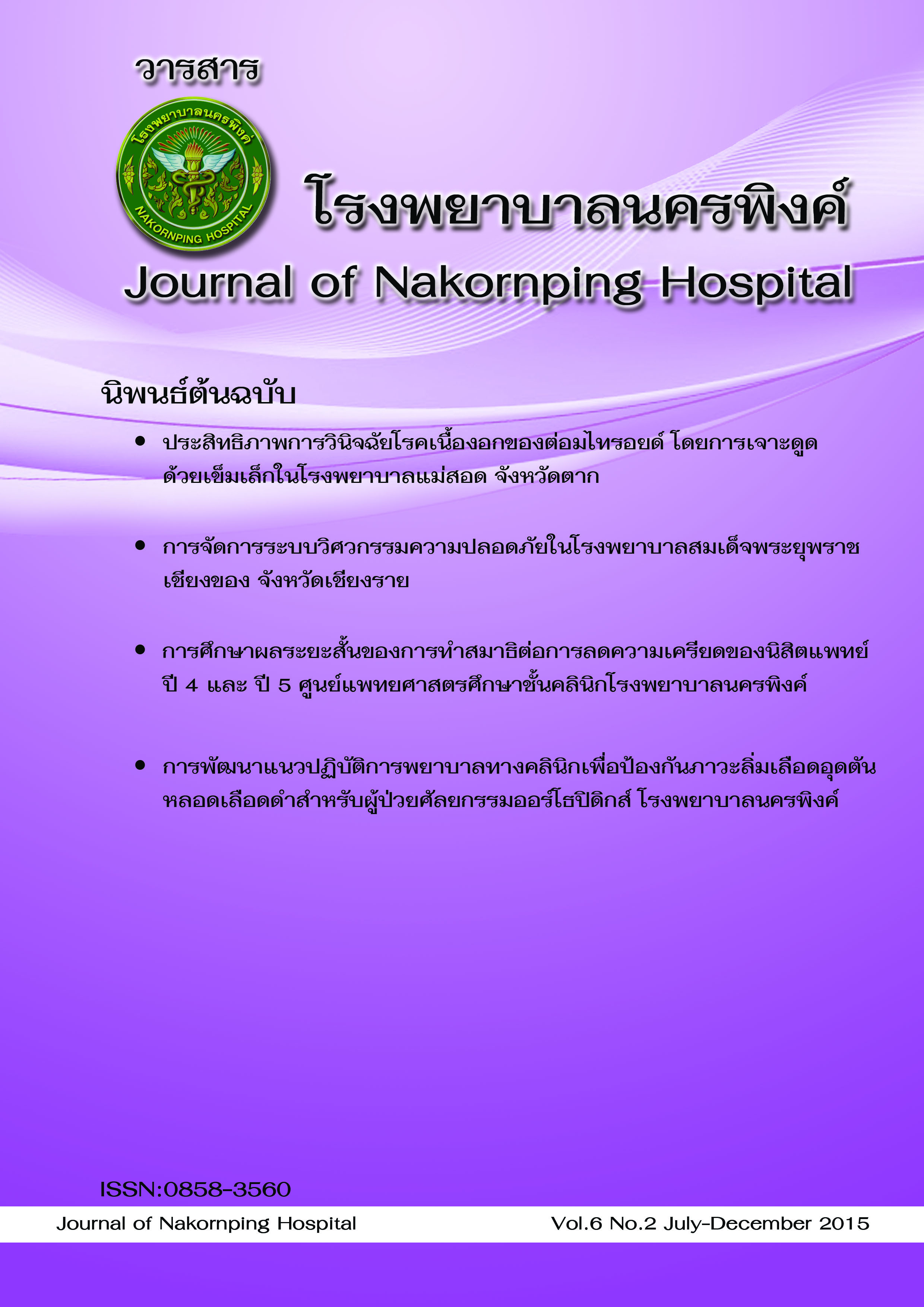Effects of meditation to stress reduction in medical students
Keywords:
stress, medical students, meditationAbstract
Background: Stress is one of the most important issues found among medical students. Many studies have been reported that medical school practices are a prevalent cause of anxiety and emotional stress in medical students. The major causes of stress relate to the students’ course works and family problems. A high level of stress may have a negative effect on cognitive functioning and learning in medical students. Since it has shown that meditation could result in muscle relaxation throughout the body, meditation can be used to lower that stress level as a whole. This can be useful in the development learning abilities of medical students. The purpose of this research was to determine whether meditation could reduce the stress level of
the medical students at Nakornping Medical Education Center.
Objective: To study the effects of meditation on stress reduction in the fourth and fifth year medical students.
Design: Experimental research one group pretest-posttest design Summary of work: Demographic data, stress factors and stress management techniques werecollected from every subject. The research was conducted at Wat Tam DoiTohn (DoiTohn Buddhism monastery) in which a research designed experimental group consisting of 19 medical students (9 forth-year and 10 fifth-year medical students) participated in the 3-day meditation course. Then, the stress level was interpreted using the Suanprung Stress Test-20, which
measures the level of stress in four categories: mild, moderate, high and severe stress levels. The students were subjected to take the test before and after attending the meditation course. Afterwards, the stress test scores were compared.
Summary of results: There are 19 subjects in total consisting of 4 males and 15 females. The average age of the subjects is 30.7 years old in which 36% lives in urban areas while 64% lives in the suburbs and rural regions. It is reported that the stress factors of the subjects mainly relate to academic activities such as course works, interpersonal relationship, and school regulations. This factor is 58% of the overall stress factor while another 26% is due to family and finance and the final 16% is due to the environment. In regards to how the students cope with stress, the survey shows that 47.5% deals with stress by means of recreational activities such as reading, playing games, watching movies and listening to music, 47.5% coping by accepting the truth and seeking social support while only 5% copes by meditation. The test results before attending the
meditation course showed that most of student (64%) had moderate stress, 26% had high stress, 5% had severe stress and 5% had mild stress. The mean score of the stress test before and after attending the meditation course is 42.21 and 36.95, respectively. The result of the Suanprung Stress Test-20 proves that the stress level of the pre- and post-test reduces with the significance of P=0.029 Discussion and conclusion: The result of the Suanprung Stress Test-20, which the subjects took before and after attending the meditation course, shows significant decrease of stress. It is evident that meditation can serve as another mean of coping with stress. In this research we investigated the short-term effects of meditation on the stress level where the students were subjected to the 3-day meditation course. It might be beneficial for the future researchers to conduct long-term effects of mindfulness training for medical and pre-medical students.
Take-home message: The 3 day meditation course is an effective method for managing stress in
medical students
References
ในนักศึกษาแพทย์ชั้นปีที่ 2-6 ของคณะแพทย์แห่งหนึ่งในประเทศไทย. วารสารสมาคมจิตแพทย์แห่งประเทศไทย
2557;59(1):29-40.
2. ชัยวัชร์ อภิวาทนสิริ, กฤติยา โสมะเกษตรินทร์, กิตติศักดิ์ สุรประยูรและคณะ. ความเครียดและการจัดการ
ความเครียดของนักศึกษาแพทย์ชั้นคลินิกมหาวิทยาลัยขอนแก่น. Srinagarind Med J 2007;22:131.
3. เธียรชัย งามทิพย์วัฒนา, สุชีรา ภัทรา จตุวรรตน์, มาลัย เฉลิมชัยนุกูล. ความเครียดและรูปแบบการแก้ปัญหาของ
นักศึกษาแพทย์ชั้นปีที่ 3 คณะแพทยศาสตร์ศิริราชพยาบาล. วารสารสมาคมจิตแพทย์แห่งประเทศไทย 2543;
45(1):59–69.
4. รุ่งรัตน์ ระย้าแก้ว, วัลลี สัตยาศัย. ความเครียดของนิสิตแพทย์ชั้นปีที่ 4-6 กรณีศึกษาศูนย์แพทยศาสตรศึกษาชั้น
คลินิก โรงพยาบาลพุทธชินราช พิษณุโลก. ธรรมศาสตร์เวชสาร 2556;13(1):17-22.
5. สุวรรณา สี่สมประสงค์. การศึกษาความเครียดของนักศึกษาแพทย์ระดับชั้นปีที่ 4-6.สารนิพนธ์ กศ.ม. (จิตวิทยาการ
แนะแนว). กรุงเทพฯ:บัณฑิตวิทยาลัย มหาวิทยาลัยศรีนครินทรวิโรฒ. 2552.
6. วลุลี โพธิรังสิยากร. ความเครียด วิธีผ่อนคลายและความคิดเห็นของนิสิตแพทย์ชั้นปีที่ 3 มหาวิทยาลัยนเรศวรต่อการ
จัดมุมสบายคลายเครียดของห้องสมุด. พุทธชินราชเวชสาร 2550;24(3): 306-16.
7. พนิดา สังฆพันธ์, ประภาพร ตั้งธนธานิช, ลักคณา สาระรัตน์ และคณะ. ปัญหาความเครียดและสุขภาพจิตของ
นักศึกษาสัตวแพทย์มหาวิทยาลัยขอนแก่น. วารสารนวัตกรรมการเรียนการสอน 2549; 3(1)17-30.
8. กาญจนี โชติชัยวิวงศ์กุล. (2547). ปัจจัยบางประการที่เกี่ยวข้องกับความเครียดของนักศึกษาแพทย์ชั้นปีที่ 1 คณะ
แพทยศาสตร์ศิริราชพยาบาล มหาวิทยาลัยมหิดล. ปริญญาานิพนธ์กศ.ม. (จิตวิทยาพัฒนาการ). กรุงเทพฯ:บัณฑิต
วิทยาลัย มหาวิทยาลัยศรีนครินทร์วิโรฒ ประสานมิตร
9. Yusoff M.S.B., Rahim A.F.A., Baba, A.A. Prevalence and associated factors of stress, anxiety and
depression among prospective medical students. Asian Journal of Psychiatry 2013;6:128-33.
10. วรัชฌา คุณาดิศร, จารุรินทร์ ปิตานุพงศ์. ภาวะสุขภาพจิตและปัจจัยที่สัมพันธ์ในนักศึกษาแพทย์
มหาวิทยาลัยสงขลานครินทร์.สงขลานครินทร์เวชสาร 2553;28(3):139-44.
11. กรมสุขภาพจิต. คู่มือคลายเครียด (ฉบับปรับปรุงใหม่). กรุงเทพฯ:กระทรวงสาธารณสุข,2551
12. นิธิพันธ์ บุญเพิ่ม. ความเครียดและการจัดการความเครียดของนักศึกษาวิทยาลัยการแพทย์แผนไทย มหาวิทยาลัย
เทคโนโลยีราชมงคลธัญบุรี. การค้นคว้าอิสระหลักสูตรปริญญาวิทยาศาสตร์มหาบัณฑิตวิทยาลัย มหาวิทยาลัย
ศิลปากร, 2553.
13. Cheryl R, Dylan G, Annabel P. Interventions to reduce stress in university students: A review and
meta-analysis. Journal of Affective Disorders 2013; 148:1–11.
14. Julie AI, Patricia LD, Jeeseon P. Cultivating mindfulness in health care professionals: A review of
empirical studies of mindfulness-based stress reduction (MBSR).Complementary therapies in
clinical practice 2009; 15(2):61-6.
15. Khoury B, Lecomte T, Fortin G. et al. Mindfulness-based therapy: a comprehensive meta-analysis.
Clin Psychol Rev.2013;33 (6): 763-7
16. Shapiro SL, Brown KW, Astin JA.Toward the Integration of meditation into Higher education: A
review of research.The center for contemplative mind in society. Available from
www.contemplativemind.org/archives/830
17. Ludwig D. Kabat-Zinn J. Mindfulness in medicine.JAMA 2009;300:1350–52.
18. ทัศนา บุญทอง, วิไล นาป่า, วาสนา แฉล้มเขตร และคณะ. ผลของการผ่อนคลายแบบเกร็งกล้ามเนื้อต่อระดับความ
วิตกกังวลในผู้ป่วยโรคหอบหืด. Rama Nurs J 2010;16(1):136-49.
19. สุวัฒน์ มหัตนิรันดร์กุล. วนิดา พุ่มไพศาลชัย. พิมพ์มาศ ตาปัญญา. รายงานการวิจัยเรื่องการสร้างแบบวัด
ความเครียดสวนปรุง. โรงพยาบาลสวนปรุง จังหวัดเชียงใหม่. พฤษภาคม 2540.
20. พระปาโมทย์ ปาโมชโช.วิธีการปฏิบัติธรรม. กลุ่มวิมุตติ. กรุงเทพฯ. พฤษภาคม 2551. Available from
https://www.wimutti.net
21. Teasdale, J. D., Segal. Et al. Prevention of relapse/recurrence in major depression by mindfulnessbased cognitive therapy. Journal of Consulting and Clinical Psychology2000;68:615–23.
Downloads
Published
How to Cite
Issue
Section
License
The articles that had been published in the journal is copyright of Journal of Nakornping hospital, Chiang Mai.
Contents and comments in the articles in Journal of Nakornping hospital are at owner’s responsibilities that editor team may not totally agree with.



